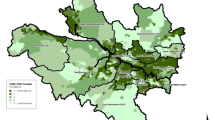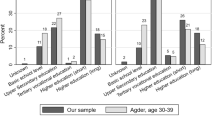Abstract
Purpose
This study aimed to identify whether nonparental preschool childcare was associated with adolescent mental health outcomes as measured by the strengths and difficulties questionnaire (SDQ).
Method
This study was a secondary analysis of data from the Croydon Assessment of Learning Study. From a general population sample of 2,726 adolescents tested for cognitive ability, additional data were collected from a stratified sub-sample of 197 subjects. A semi-structured interview asked parents about preschool childcare and early development concerns. Parent and teacher SDQ and IQ data were collected. Complete data were available from 167 subjects. Using nonparental preschool childcare as the ‘treatment’ effect and parental childcare as the ‘control’, propensity score matching analyses were used to analyse the effect of nonparental childcare on adolescent SDQ outcomes.
Results
Nonparental childcare was reported by 49% of the sample and was not significantly associated with conduct, emotional, peer or prosocial SDQ subscales, but was found to have a significant average treatment effect on symptoms of attention/hyperactivity, on average raising the symptom subscale score by 1.8 (95% confidence interval 0.12–3.65). The propensity score analysis ensures the results could not be explained by the available measures that influenced receiving nonparental care. Increased time spent in nonparental childcare was associated with greater attention/hyperactivity symptoms.
Conclusions
Nonparental preschool care showed little association with generalized psychopathology but may be associated with hyperactivity and inattention problems. Replication of these findings in prospective studies is required.
Similar content being viewed by others
References
Scarr S, Phillips D, McCartney K (1989) Working mothers and their families. Am Psychol 44:1402–1409
Sorbie A (2007) Provision for children under five years of age in England: January 2007. Statistical First Release. Department for Education and Skills
Bradley RH, Vandell DL (2007) Childcare and the well-being of children. Arch Pediatr Adolesc Med 161:669–676
US Department of Labor. www.dol.gov/whd/fmla
NICHD Early Child Care Research Network (1999) Childcare and mother-child interaction in the first 3 years of life. Develop Psychol 35:1399–1413
NICHD Early Child Care Research Network (2003) Early childcare and mother–child interaction from 36 months through first grade. Infant Behav Develop 26:345–370
NICHD Early Child Care Research Network (1998) Early child care and self-control, compliance and problem behaviour at 24 and 36 months. Child Develop 69:1145–1170
NICHD Early Child Care Research Network (2001) Child care and children’s peer interaction at 34 and 36 months: the NICHD Study of Early Child Care. Child Develop 72:1478–1500
NICHD Early Child Care Research Network (2003) Does amount of time spent in child care predict socio-emotional adjustment during the transition to kindergarten? Child Develop 74:976–1005
NICHD Early Child Care Research Network (2006) Childcare effect sizes for the NICHD study of early childcare and youth development. Am Psychol 61:99–116
Aureli T, Colecchia N (1996) Day care experience and free play behaviour in preschool children. J Appl Develop Psychol 17:1–17
Campbell J, Lamb ME, Hwang C (2000) Early child care experiences and children’s social competence between 1.5 and 15 years of age. Appl Develop Sci 4:166–175
Brooks-Gunn J, Han W, Waldfogel J (2002) Maternal employment and child cognitive outcomes in the first years of life: the NICHD Study of Early Child Care. Child Dev 73:1052–1072
Vandell DL, Ramanan J (1992) Effects of early and recent maternal employment on children from low-income families. Child Dev 63:938–949
NICHD Early Child Care Research Network (2004) Type of child care and children’s development at 54 months. Early Child Res Q 19:203–230
Dench G, Ogg J, Thomson K (1999) The role of grandparents. British Social Attitudes: the 16th Report. Published by Ashgate (Aldershot) for the National Centre for Social Research, Hampshire
La Valle I, Finch S, Nove A, Lewin C (1999) Parents’ demand for childcare. DfEE research report RR176. Department for Education and Employment, Sheffield
Loeb S, Fuller B, Kagan SL, Carrol B (2004) Childcare in poor communities: early learning effects of type, quality and stability. Child Dev 75:47–65
Clarke-Stewart KA (1987) Predicting child development from child care forms and features: the Chicago Study. In: Phillips DA (ed) Quality in child care: what does research tell us?. National Association for the Education of Young Children, Washington, DC
NICHD Early Child Care Research Network (2000) Characteristics and quality of child care for toddlers and preschoolers. Appl Develop Sci 4:116–135
Reynolds AJ, Temple JA (1998) Extended early childhood intervention and school achievement: age 13 findings from the Chicago Longitudinal Study. Child Dev 69:231–246
Reynolds AJ, Temple JA, Robertson DL, Mann EA (2001) Long-term effects of an early childhood intervention on educational achievement and juvenile arrest: a fifteen year follow-up of low-income children in public schools. J Am Med Assoc 285:2339–2346
Fergusson E, Maughan B, Golding J (2008) Which children receive grandparental care and what effect does it have? J Child Psychol Psychiatry 49:161–169
NICHD Early Child Care Research Network (2007) Are there long-term effects of early child care? Child Develop 78:681–701
Rosenbaum PR, Rubin DB (1983) The central role of the propensity score in observational studies for causal effects. Biometrika 70:41–55
Simonoff E, Pickles A, Chadwick O, Gringras P, Wood N, Higgins S, Maney J, Karia N, Iqbal H, Moore A (2006) The Croydon Assessment of Learning Study: prevalence and educational identification of mild mental retardation. J Child Psychol Psychiatry 47:828–839
Census 2001 (2004) CD supplement to the National Report for England and Wales and Key Statistics for Local Authorities in England and Wales. Office of National Statistics, London
Thorndike RL, Hagen E (1986) Cognitive abilities test. NFER-Nelson, Windsor (UK)
Wechsler D (1992) The Wechsler intelligence scale for children, 3rd edn. The psychological Corporation, London
Goodman R (1997) The strengths and difficulties questionnaire: a research note. J Child Psychol Psychiatry 38:581–586
Goodman R (2001) Psychometric properties of the strengths and difficulties questionnaire. J Am Acad Child and Adolesc Psychiatry 40:1337–1345
Goodman R, Ford T, Simmons H, Gatward R, Meltzer H (2000) Using the strengths and difficulties questionnaire (SDQ) to screen for child psychiatric disorders in a community sample. Br J Psychiatry 177:534–539
Wechsler D (1999) Wechsler abbreviated scale of intelligence (WASI). London, The Psychological Corporation
Rydell A (2010) Family factors and children’s disruptive behaviour: an investigation of links between demographic characteristics, negative life events and symptoms of ODD and ADHD. Soc Psychiatry Psychiatr Epidemiol 45:233–244
Prechtl H (1980) The optimality concept. Early Hum Dev 4:201–205
Leete R, Fox J (1977) Registrar general’s social classes: origins and uses. Popul Trends 8:1–7
Binder DA (1983) On the variances of asymptomatically normal estimators from complex surveys. Int Stat Rev 51:279–292
Statacorp (2007) Stata 10 Base Reference Manual. College Station, Stata Corporation, TX
Goodman R, Ford T, Corbin T, Meltzer H (2004) Using the strengths and difficulties questionnaire (SDQ) multi-informant algorithm to screen looked-after children for psychiatric disorders. Eur Child Adolesc Psychiatry 13:1125–1131
NICHD Early Child Care Research Network (2003) Do children’s attention processes mediate the link between family predictors and school readiness? Develop Psychol 39:581–593
NICHD Early Child Care Research Network (2005) Predicting individual differences in attention, memory and planning in first graders from experiences at home, child care and school. Develop Psychol 41:99–114
Ruff HA, Rothbart MK (1996) Attention in early development: themes and variations. Oxford University Press, New York
Conflict of interest
None of the authors have any conflicts of interest.
Author information
Authors and Affiliations
Corresponding author
Rights and permissions
About this article
Cite this article
Liang, H., Pickles, A., Wood, N. et al. Adolescent emotional and behavioural outcomes of nonparental preschool childcare. Soc Psychiatry Psychiatr Epidemiol 47, 399–407 (2012). https://doi.org/10.1007/s00127-011-0351-2
Received:
Accepted:
Published:
Issue Date:
DOI: https://doi.org/10.1007/s00127-011-0351-2




